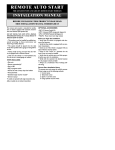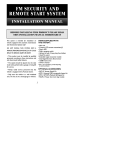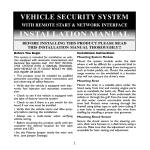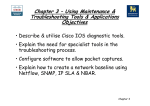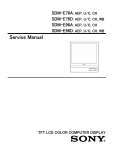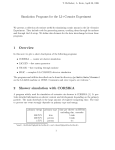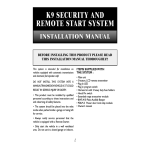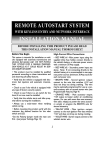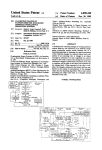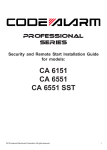Download Black Widow Security BW RAS 130 Installation manual
Transcript
SECURITY SYSTEM W/ BUILT-IN REMOTE AUTO START INSTALLATION MANUAL BEFORE INSTALLING THIS PRODUCT PLEASE READ THIS INSTALLATION MANUAL THOROUGHLY!! SYSTEM CONTENTS: This system is intended for installation on vehicles equipped with automatic transmissions and electronic fuel injection only! DO NOT INSTALL THIS UNIT INTO A MANUAL TRANSMISSION VEHICLE AS IT COULD RESULT IN SERIOUS INJURY OR DEATH. • Main unit • 4-button remote transmitter(s)* • Plug In LED • Plug in program switch • Harness kit with 2 heavy duty fuse holders • Hood Pin switch • Extended range transceiver module • Dual Stage Electronic Shock sensor • 120dB 6-tone siren • Owner’s manual • This product must be installed by qualified personnel according to these instructions and and observing all safety features. • The system should be placed into the valet mode when parked inside a garage or being left for service. *S-models provided with single transmitter OPTIONAL ACCESSORIES: • Always notify service personnel that the vehicle is equipped with a Remote Starter. • VAC-10 Vacuum Switch Kit • APP-1 Universal OEM transponder bypass kit • APV-1 GM VATS, Passlock I&II bypass kit • PDLM-3 Power door lock relay module • Only start the vehicle in a well ventilated area. Do not use in a closed garage or indoors. 1 Before you begin the installation: • Verify that the vehicle is equipped with electronic fuel injection. • Verify that the vehicle is equipped with an automatic transmission. • Check to see if the vehicle is equipped with any type of factory security system. • Check to see if there is a pin switch for the hood, if not one must be installed. • Verify that the vehicle starts and idles properly before you start the installation. • Verify with the customer the desired location for the program switch and LED. • Always use a multi-meter when verifying vehicle wiring. Remote Start Installation Notes: The system senses the vehicle’s successful start using one of the following methods: 1. Current sense 2. Tachometer sense 3. Spark or Coil Wire sense 4. Using optional vacuum switch. If the Current Sense feature does not allow proper operation, the tachometer sense/spark sense wire may be used, or an optional vacuum switch can be installed. uum switch can be installed. The vacuum switch is designed to be placed in line with one of the vehicle’s vacuum hoses and provide a ground output (N/C) until the engine is started. To use the vacuum switch, set dip switch #2 to the off position. Connect the yellow wire (3-pin red connector) to one terminal of the vacuum switch and connect the other terminal to ground. High-Current Wire Connections: • RED WIRE #1 -Main power input; using the supplied inline fuse holder, connect directly to the vehicle’s battery or alternate power source with a minimum 30 Amp supply. • RED WIRE #2 - Secondary power input; using the supplied inline fuse holder, connect directly to the vehicle’s battery or alternate power source with a minimum 30 Amp supply. Note: If not connecting directly to the vehicle’s battery, it is recommended to use separate power sources (minimum 30 Amp each) for each red power wire. • BROWN WIRE - Second ignition output; connect to the wire that switches +12V and does not drop out during cranking. • YELLOW WIRE - Main ignition output; connect to the main ignition wire that switches +12 V and does not drop out during cranking. To use the tach sense/spark sense wire, set dip switch #4 to the off position. Connect the gray wire directly to the vehicle’s tach wire or extend it into the engine compartment and wrap it several times around a spark plug or coil wire. • ORANGE WIRE - Main accessory output; This provides +12V output to heater and/or air conditioning system. Some cars may have more than one accessory wire. In these vehicles add a relay(s) to power the extra accessory wire(s). In situations were a tach wire is unavailable or does not allow proper operation, an optional vac- • PURPLE WIRE - Starter output; connect to the vehicle’s starter wire. 2 Main Harness: the vehicle’s tach wire or negative fuel injector wire, and set dip switch #4 to OFF. If the tach wire is not accessible, wrap the GRAY wire around a spark plug wire or coil wire several times and secure with electrical tape. • WHITE WIRE - Parking light output (+). Connect to the wire that switches to +12V when the parking lights are turned on. If the vehicle’s parking light circuit exceeds 10 amps a relay is required. For vehicle’s with independent left and right parking light circuits, the parking light wires must be connected using diodes to keep the circuits separate. • GREEN WIRE - Negative door trigger (-). Connect to the door switch circuit wire that shows ground when the door is open. • BLUE WIRE - Hood switch input wire (-). Connect this wire to the hood pin switch, this will prevent the vehicle from remote starting if the hood is opened. This is a safety input and must be connected on all installations. • RED WIRE - +12V battery input. • BROWN WIRE - Siren wire output (+). Connect to the siren’s red wire. Connect the siren’s black wire to ground. • VIOLET WIRE - Positive door trigger (+). Connect to the door switch circuit wire that shows +12V when the door is open. This type of door circuit is usually found on Ford vehicles. • BLACK WIRE - Ground input (-). Connect to a solid chassis ground that is clean and free of paint or dirt. • ORANGE WIRE - Armed Output and Ground When Running Output (-). Connect to a relay for starter defeat and starter anti-grind protection. (See installation diagrams). The ORANGE wire functions as a dual-purpose wire. It provides a ground when the unit is armed to activate a starter disable relay (using a starter disable relay also provides starter anti-grind protection). It also provides a ground when the remote start is engaged to activate an optional factory security bypass module. When the Stopand-Go mode is engaged, the output will turn on and remain active even after pressing the brake pedal. Although the remote start shuts down when the brake pedal is pressed, the output will remain on until the ignition key is turned off. • YELLOW WIRE - Brake switch input wire, connect this wire to the brake switch wire that provides +12V when the brake pedal is pressed. This is a safety input and must be connected on all installations. Plug in Connectors: 4-Pin White Connector: Plug-in connector port for dual stage shock sensor. 3-Pin White Door Lock Connector: Plug-in connector port for door lock harness or optional door lock relay module (PDLM-3). • BLUE WIRE - negative unlock output (-). • RED WIRE - constant +12V low current output (+) for relay modules, or inverters. 100mA relay trigger only. Do NOT use as a power source for door lock relays. • GRAY WIRE - Tach/Spark sense wire. If the current sensing feature does not allow desired operation, connect the GRAY wire directly to • GREEN WIRE - negative lock output (-). 3 3-Pin Red Connector: Plug-in connector port for optional features harness. 2-Pin Red Connector: Plug-in connector port for LED. Mount LED in an area where it may be easily seen from either side of the vehicle. • GREEN/BLACK WIRE - 3rd channel output (-). Connect to a relay for optional trunk release etc. 2-Pin Blue Connector: Plug-in connector port for program/service switch. Mount program switch in an area that is easily accessible from the driver’s position. • RED WIRE - Factory Disarm output (-). Connect to the wire that requires a ground pulse to disarm the factory alarm system. The RED wire provides a ground pulse when the remote transmitter is used to unlock the doors or start the vehicle. 2-Pin White Connector: Plug-in connector port for horn honk/dome light harness. • WHITE/YELLOW - horn output (-) • RED/BLACK - Dome light output (-) • YELLOW WIRE - Vacuum Switch input. For diesel vehicles, or vehicles where a tach wire or spark plug wire is not available, the YELLOW wire may be connected to an optional vacuum switch. Connect the other side of the vacuum switch to ground. 5-Pin Antenna Connector: Plug-in connector port for extended range receiver. Plug harness into 5-pin connector, route cable up pillar post, place double sided tape on flat side of receiver module and place in corner of windshield. Remote Programmable Features: Step 1. 2. 3. 4. 5. 6. 7. 8. 9. 10. 11. 12. 13. 14. 15. 16. Function Arming Mode Passive Lock Auto Re-arm Normal/Silent Arming Door Unlock Pulse Door Lock Pulse Length Ignition Lock Auto Cold Start Defeat Cold Start Timing Trunk Disarm Feature Passive Arm Warning Chirps Delete Open Zone Chirp Timing Remote Start Run Time Lock Before & After Engine Crank Lock After Engine Shutdown Parking Light Operation Button 1 (On) Passive On On Normal Single .75 Seconds On Disable Cold Start Every 2 Hours Disable On 10 Seconds 15 Minutes On On Normal 4 Button 2 (Off) Active Off Off Silent Double 3 Seconds Off Enable Cold Start Every 1 Hour Enable Off 60 Seconds 25 Minutes Off Off Car Locator Feature Remote Programmable Features Program #5: Door Unlock Pulse On = Single Off = Double Program #6: Door Lock Pulse Length On = 0.7 second door lock/unlock pulse Off = 3 second door lock/unlock pulse Program #7: Ignition Lock On = Ignition auto lock Off = No ignition auto lock Program #8: Auto Cold Start Defeat On = Disable Auto Cold Capability Off = Enable Auto Cold Capability Program #9: Cold Start Timing On = Cold start every 2 hours Off = Cold start every 1 hour Program #10: Trunk Disarm Feature On = Disabled Off = Enabled Program #11: Passive Arm Warning Chirps Delete On = Passive arming without warning chirps Off = Passive arming with warning chirps Program #12: Open Zone Chirp Timing On = Standard - 10 seconds Off = Delayed - 60 seconds Program #13: Remote Start Run Time On = 15 minutes Off = 25 minutes Program #14: Lock Before & After Engine Crank On = Lock when remote start activates Off = Disabled Program #15: Door Lock After Shut Down On = Lock when remote start shuts down Off = Disabled Program #16: Parking Light Operation On = Normal Off = Car finder feature To enter program mode: 1. Turn ignition to the on position. 2. Wait 2 seconds. 3. Within 10 seconds press program switch 5 times. 4. The siren will give one long chirp indicating the system is now in program mode. To change programmable features: Press program switch the number of times that equal to the feature you wish to change. The siren will chirp each time the switch is pushed. (Example: to turn feature #3 off press the program switch 3 times). • Press button 1 on the remote to turn the feature on, the siren will chirp once. • Press button 2 on the remote to turn feature off- siren will chirp twice. System will automatically exit program mode. NOTE: You must re-enter program mode for each feature you wish to change. Programmable Features Program #1: Arming Mode On = Passive Off = Active Program #2: Passive Lock On = Passive w/lock Off = Passive no lock Program #3: Auto Re-arm On = Auto Re-arm enabled Off = Auto Re-arm disabled Program #4: Normal/Silent Arming On = Normal operation Off = Silent operation 5 Default Reset 2. Within 5 seconds, press and hold program switch for approximately 2 seconds. • The LED will light solid • Parking lights will flash once • The siren will chirp once To exit valet mode: 1. Turn ignition to the on position. 2. Within 5 seconds press and hold program switch for approximately 2 seconds. • The LED will turn off To reset all programmable features to their factory default settings: 1. Turn ignition to the on position. 2. Wait 2 seconds. 3. Within 10 seconds press program switch 5 times. The siren will give one long chirp indicating the system is now in program mode. 4. Press transmitter button 3. The siren will chirp 3 times and all programmable features will be reset to the On position. Adding or Deleting Remote Controls When you enter the code learning mode, the system will learn new remotes and automatically delete all other remotes that were previously operating the system. NOTE: You must code all desired remotes at this time. The system can learn a maximum of three transmitters. Dip Switch Settings Make sure to set all dip switches in proper position prior to mounting the module. Dip Switch #1: Diesel Mode On = Standard mode Off = Diesel mode - Ignition turns on for 1213 seconds prior to cranking the starter (to allow glow plugs to warm up). Dip Switch #2: Vacuum switch On = Current sense or tach/spark sense Off = Vacuum switch sense Dip Switch #3: Starter cranking time On = Standard crank time Off = Extended crank time (auto adjusts) Dip Switch #4: Tach/Spark sense On = Current sense Off = Tach/Spark sense To enter Code Learning Mode: 1. Turn ignition key on, off, on, off, and leave on within 5 seconds. LED will flicker and parking lights will flash once. 2. Press and hold program switch for 2 seconds. 3. LED will flicker and parking lights will flash. The siren will give a series of chirps (as long as arming chirps are on). 4. Release the program switch. 5. Program all desired remotes by pressing button #1 on each of the transmitters. The siren will chirp after the system has learned each remote control (as long as arming chirps are on). 6. Turn ignition key off. Remotes are now programmed to the system. Valet Mode When the Valet mode is activated, the vehicle will not start using the remote, but keyless entry functions will still operate. To enter valet mode: Bypassing Factory Theft Deterrent 1. Turn ignition to the on position. 6 Bypassing Factory Theft Deterrent Systems Nissan and others). This system requires use of a tiny passive transmitter housed in the base of the key.This device activates when placed close to the vehicle’s ignition switch. The starter will usually crank but the fuel system will be disabled, mot allowing the vehicle to run, if the transponder is not detected. To properly interface into transponder systems, use the APP-1 module. This module allows full functionality of the factory anti-theft system and requires the use of a spare key. Many newer vehicles are now factory-equipped with anti-theft systems that use either a resistor coded key or a passive transponder that disables the fuel system unless a properly coded key is inserted into the ignition cylinder. To integrate a remote starter into these vehicles, you must determine which type of factory antitheft system is equipped, then use the proper bypass module for that system. General Motors Anti-theft Systems: Many late-model GM vehicles are equipped with one of three basic anti-theft systems; Passkey, Passlock, and Passkey 3. Standard Passkey systems are easily identified by the resistor chip visible on the shaft of the key. Passlock systems do not rely on a resistor equipped key. Instead they use a resistance code generated when the key is turned in the ignition cylinder. Both of these systems have an anti-theft indicator in the instrument cluster. To properly interface into these systems and retain full functionality of the factory anti-theft system, use the APV-1 module. The Passkey 3 system, which is found on GM vehicles 1999 and newer, is a transponder based system (described below). Use the APP-1 module to integrate into Passkey 3 equipped vehicles. This module allows full functionality of the factory anti-theft system and requires the use of a spare key. Passive Transponder Systems: Passive transponder systems have become the most popular anti-theft system among vehicle manufacturers (Ford, Honda, BMW, Toyota, 7 SECURITY/REMOTE START WIRING DIAGRAM +12V LOCK(-) BLUE GREEN/BLACK RED RED GREEN LED SHOCK SENSOR PLUG TRUNK OUTPUT (-) FACTORY DISARM OUTPUT (-) YELLOW VACUUM SWITCH INPUT SWITCH UNLOCK(-) WHITE/YELLOW HORN OUT(-) RED/BLACK DOME LIGHT (-) RF RECEIVER WHITE PARKING LIGHT OUTPUT (+) RED DIP SWITCH SETTINGS Default settings from factory are ON SIREN OUTPUT(+) BLACK GROUND INPUT 2 3 4 WIRING HARNESS 1 1. ON = Normal operation OFF = Diesel mode - ignition will turn ON several seconds before starting vehicle. 2. ON = Normal operation OFF = Vacuum switch mode - reads YELLOW wire (3-pin accessory plug) for optional vacuum switch 3. ON = Normal operation OFF = Extend cranking time - automatically adjusted 4. ON = Dip switch #2 selection (normal/vacuum) OFF = Tach/Spark sense - reads GRAY tach/spark sense wire. ORANGE TACH/SPARK SENSE (-) GREEN DOOR TRIGGER (-) BLUE VIOLET VIOLET #1 ORANGE #2 YELLOW #3 CONNECTORS #5 RED #6 RED FIGURE 1. OPTIONAL VACUUM SWITCH INSTALLATION EXISTING CAR VACUUM HOSE VACUUM SWITCH BROWN #4 ARMED OUTPUT/ GROUND WHEN RUNNING (-) GRAY YELLOW GROUND +12V INPUT BROWN HOOD SWITCH INPUT(-) DOOR TRIGGER (+) BRAKE SWITCH INPUT (+) STARTER OUTPUT ACCESSORY OUTPUT IGNITION #1 OUTPUT IGNITION #2 OUTPUT CONNECT EACH DIRECTLY TO THE BATTERY (See page 2 ) COLD START ACTIVATION Automatically starts engine every 1 or 2 hrs. for 24 hrs. max. While pressing brake pedal, push program switch then press transmitter button 4. The parking lights will flash 5 times and remain on. Engine will start and run for 30 seconds to confirm activation, then shut down. Once activated the engine will start automatically and run for the preset run time. YELLOW WIRE (VACUUM SWITCH INPUT ON MAIN UNIT EXISTING CAR VACUUM HOSE COLD START DEACTIVATION The Cold Start feature can be deactivated by stepping on the brake pedal, or remote starting the vehicle using the transmitter. For optional vacuum switch installation: dip switch #2=OFF 8 REMOTE START TROUBLESHOOTING Problem Unit will not operate. Probable Cause Suggested Correction All power inputs are not con- Main Inputs (heavy gauge red nected to +12V. wires) and small red wire on main harness must be connected to +12V. Keyless Entry features operate System in Service Mode LED is Turn ignition key to on position, press and hold service switch for but vehicle will not start. on solid. 5 seconds.The LED will turn off. Vehicle will not remote start. Safety inputs are triggered. Engine cranks but not long Crank time must be increased. enough to allow vehicle to start. Check Brake Switch Input (+) (Yellow Wire) or Hood Input (-) (Blue Wire). Place dip switch #3 to the ON position. System will not go into Code Ignition #1 (Yellow Wire ) is on Connect the main ignition output to the Ignition #1 connecLearning or Programming Mode. wrong connector - Ignition #2 tor on the main unit. Car horn honks and vehicle will Vehicle has a factory alarm sys- Connect red wire on accessory plug (red plug) to Factory Alarm not start. tem. Disarm wire. Vehicle starts without pressing System in Automatic Cold Start To exit press brake pedal or turn Ignition key on, or activate Remote Transmitter. Activation Mode. remote start using the remote transmitter. Vehicle cranks and begins to run, Voltage sense is not working. Wrap the gray wire around a then shuts off. Use either the spark sense or spark plug wire or connect to either the tach wire or a negative tach sense. fuel injector wire. Set dip switch #4 in the OFF position. Vehicle cranks and begins to run, Vehicle has a factory theft deter- See Bypassing Factory Theft then shuts off. rent system that prevents start- Deterrent Systems. ing w/o key in ignition. 9 SECURITY SYSTEM TROUBLESHOOTING Problem Probable Cause Suggested Correction Alarm will not go into Code Learning Mode. RED or YELLOW wire not connected to the correct power source. Code Learning sequence performed too slowly. RED wire should connect directly to the battery. Connect YELLOW wire to true ignition wire (NOT AT FUSE BLOCK). Perform Code Learning sequence faster. Alarm will not rearm or will not passively arm. Door is open,VIOLET wire is connected to positive voltage, GREEN wire is connected to ground, main YELLOW wire (ignition wire) is connected to +12V, or door pin switch is bad. Check VIOLET and GREEN wires with doors closed and open, and YELLOW wire with ignition switch off and on for voltage changes. Repair and/or rewire as needed. Flashing light output does not work. Bad connection on WHITE wire or the output polarity is wrong for the circuit being driven. Check WHITE wire. Connect a SPDT relay to this wire and apply the opposite polarity to the circuit being driven. Door locks do not lock/unlock correctly, or action is reversed Defective GREEN or BLUE wire from door lock connector plug, GREEN and BLUE wires reversed, or wrong door lock wiring diagram used. Check GREEN and BLUE wires on door lock connector plug, Check vehicle’s door lock system for method of operation. Reverse wiring to door relays. STATUS INDICATOR (LED) FUNCTIONS PARKING LIGHTS FUNCTIONS On Solid = Valet Mode On Solid = Vehicle Remote Starting Slow Flash = System Armed Flash 1x = Doors Locked Rapid Flash = Passive Arming Flash 2x = Doors Unlocked Flash 2x = Remote Start Flash 3x = Stop and Go Mode Flash 4x = Cold Start Mode Flash 3x = Open Zone Indication (after arming) Flash 4x = Remote Starting Failed Flash 5x = Auto Cold Start Engaged 10 POWER DOOR LOCK RELAY DIAGRAMS: This system provides negative door lock outputs. Positive trigger or reverse polarity installations require two SPDT relays or the PDLM-3 Power Door Lock Relay Module (not included). Connect relays as shown in the illustrations provided. POSITIVE TRIGGER DOOR LOCK CIRCUIT: TO POSITIVE LOCK WIRE TO POSITIVE UNLOCK WIRE LOCK RELAY GREEN WIRE FROM ALARM UNLOCK RELAY 87 87a 87 87a 86 30 86 85 BLUE WIRE FROM ALARM 85 30 12V+ REVERSE POLARITY (ADDING ACTUATORS): GROUND GROUND FOR NEGATIVE PARKING LIGHTS (MOST JAPANESE VEHICLES) 87 87a 86 30 87 87a 86 85 12V+ BLUE WIRE FROM ALARM 85 30 LOCK RELAY UNLOCK RELAY TO VEHICLE PARKING LIGHT CIRCUIT 87 87a REVERSE POLARITY USING FACTORY SYSTEMS: 85 86 GREEN WIRE FROM ALARM 30 LOCK RELAY WHITE WIRE FROM ALARM GROUND GREEN WIRE FROM ALARM UNLOCK RELAY 87 87a 87 87a 86 86 85 30 12V+ SWITCH ACTUATOR - - X CUTX - - LOCK TRUNK RELEASE CIRCUIT DIAGRAM: BLUE WIRE FROM ALARM 85 30 -X CUT X- UNLOCK TO TRUNK RELEASE WIRE HORN HONK DIAGRAM: (GREEN/ BLACK WIRE) 87 87a 86 30 TO NEGATIVE HORN HONK WIRE TO POSITIVE HORN HONK WIRE 87 87a 87 87a 85 12V+ WHITE/ YELLOW 86 30 12V+ 85 WHITE/ YELLOW 85 86 30 12V+ GROUND ADDED RELAY TO PREVENT GRINDING STARTER AFTER REMOTE AUTO START DOME LIGHT DIAGRAM: 12V+ IGNITION IGNITION SWITCH 85 87 87a 30 86 CUT X ORANGE WIRE (MAIN HARNESS) PURPLE WIRE (HEAVY GAUGE) TO BATTERY TO STARTER MOTOR TO POSITIVE DOME LIGHT WIRE TO NEGATIVE DOME LIGHT WIRE RED/ BLACK 87 87a 86 30 12V+ 85 RED/ BLACK GROUND 11 87 87a 86 30 85 12V+ © 2001, DLC, INC. 64-130, 10/01 Rev. 2 12












